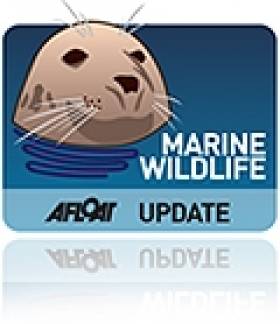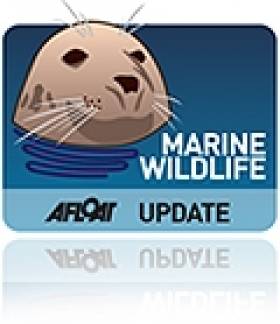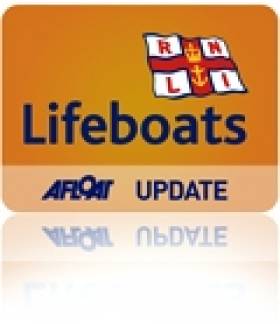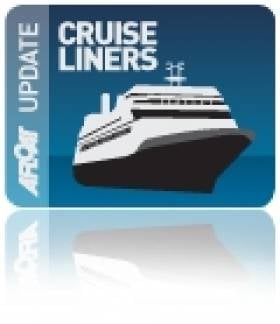Displaying items by tag: west cork
Another Humpback Whale Sighting - This Time in Northern Ireland
#MARINE WILDLIFE - The Irish Whale and Dolphin Group (IWDG) has confirmed a new humpback whale sighting, this time in Northern Ireland.
According to the IWDG, this is the third consecutive year that a humpback whale has been spotted in Northern Irish waters, with this sighting being only the fourth ever validated record for the species in the North.
IWDG sightings co-ordinator Pádraig Whooley described it as "an important development [that] highlights a trend towards increased sightings of this large baleen whale species in Irish waters."
He also remarked on the "unusual" location of the sighting in the fast-running waters of the Strangford Narrows at the Ards Peninsula.
The discovery comes just a week after confirmed sighting of two humpback whales at the opposite end of the island of Ireland, off Galley Head in West Cork, as previously reported on Afloat.ie.
Humpback Whale Sightings in West Cork Confirmed
#MARINE WILDLIFE - This past weekend saw confirmation that two humpback whales have made an unseasonal visit to Irish waters.
As previously noted on Afloat.ie, the Irish Whale and Dolphin Group (IWDG) had received reports of a sighting of the large cetaceans by birdwatchers off Galley Head in West Cork - an event described as "unusual" by sightings co-ordinator Pádraig Whooley.
But as the Irish Independent reports, those sightings have now been confirmed after IWDG members spotted the humpback pair near The Stags at Castlehaven harbour.
The team was able to get close enough to collect skin samples as well as photo identification, which confirmed that one of the duo is completely new to these waters.
Whooley commented: "Why these two young humpbacks are here during spring, when years of data shows them to be absent in these months, is a mystery."
The Irish Independent has more on the story HERE.
Humpback Whales A Surprise April Sighting Off West Cork
#MARINE WILDLIFE - At least two humpback whales have been spotted by birdwatchers off Galley Head in West Cork, according to the Irish Whale and Dolphin Group (IWDG).
"This is the first time since the large whale project commenced in 1999 that humpback whales have been recorded along the Irish south or coast during April, which has been up till now the one month in which large whales have consistently been absent from our inshore waters," said IWDG sightings co-ordinator Pádraig Whooley.
The timing of this sighting was described by Whooley as "unusual". He also confirmed that one of the whales was recorded off Hook Head in Co Wexford in late January and early February of this year, which dispells the hypothesis that large whales leave Irish waters after the herring season in the southeast.
Meanwhile, Whooley sounded a word of caution for anyone hoping to spot the humpbacks for themselves, as the "sheer numbers of basking sharks about" often result in false sightings.
The Irish Whale and Dolphin Group has more on the story, including images, HERE.
#LIFEBOATS - The latest marine notice from the Department of Transport, Tourism and Sport (DTTAS) advises of construction work being carried out on Baltimore Lifeboat Station from today 5 March.
As previously reported on Afloat.ie, the works are part of a €2.6 million State-funded project to conduct essential remedial works at harbours across West Cork this year.
The works - which will be ongoing till mid-October pending weather conditions - will involve piling immediately adjacent to the foreshore on the north-east side of the building, and the deposition of rock to form an armoured breakwater jutting some 80m into Church Strand Bay.
No forseeable impact to mariners in the area is expected, but vessels are in any case requested to proceed slowly and with caution in the approach channel to Church Strand Bay and to give the works a wide berth to avoid wave-wash.
Further details for mariners are included in Marine Notice No 9 of 2012, a PDF of which is available to read and download HERE.
'Eagle-Eyed' Angler Fishes Wedding Ring from the Lee
#ANGLING - An "eagle-eyed" angler in Co Cork received a free eye test after his remarkable find of a wedding ring in the water last week.
Seventy-five-year-old Pat O'Flaherty spotted the €400 gold band - complete with its red box - in the River Lee, garnering him a front-page story in the Irish Examiner and a free eye test from Specsavers.
They put me in the chair and did all the tests and told me I have 20:20 vision," he said.
The owner of the ring has yet to be traced, despite much speculation as to how it ended up in the Lee in the first place. If unclaimed, O'Flaherty intends to auction the ring for charity.
In other angling news, West Cork's Courtmacsherry Angling Centre hosted members of the Bradford Sea Angling Club in the UK last weekend.
Poor weather meant that the group was restricted to inshore fishing on the Friday and Saturday, but the Sunday saw a catch of ling up to 23lbs as well as pollack, coalfish, cod, haddock and whiting.
New Season of Summer Whale Watching Courses on Cape Clear
#MARINE WILDLIFE - The Irish Whale and Dolphin Group (IWDG) has announced another series of its popular whale watching courses on Cape Clear in West Cork this summer.
The courses cater for adults keen to learn more about whales and dolphins in Irish waters and how to observe, record and identify them. They will feature a mixture of workshops and field trips, including cliff and boat-based whale watches.
Three weekend courses will take place on 25-27 May, 20-22 July and 7-9 September, led by IWDG sightings co-ordinator Pádraig Whooley. All are open to IWDG members and non-members alike, but places are limited to 20 places each weekend on a first-come-first-served basis.
Admission is €70 for IWDG members (€90 for non-members), with a non-refundable deposit of €25 required. Please note that this fee does not cover transport to Cape Clear, food or accomodation (which is limited in high summer) or any boat trips. As the itinerary will be weather-dependant, some flexibility will be required.
More information on the weekends and booking details are available at the IWDG website HERE.
In other IWDG news, the group has secured another grant from the Island Foundation to continue its humpback whale research in Cape Verde this spring and summer.
A shore-based team will be stationed in Boa Vista in an area that is "possibly the most important site for breeding humbacks in the entire northeast Atlantic".
Graham Norton's 'Jaw-Dropping' Alaska Coastline Experience
#CRUISE LINERS - TV host and funnyman Graham Norton recounts his breathtaking experiences on a cruise to Alaska for the Mail on Sunday.
"Until Alaska, my own serious nautical experience was crossing the Irish Sea on a car ferry," writes the Cork native best known for his BBC chat show.
But the remoteness of the Alaskan coastline - as seen from the decks of the Crystal Symphony - struck him with a special kind of awe.
"Enjoying Alaska's natural wonders It's hard not to be amazed as you cruise into wilderness areas such as Glacier Bay because they're so jaw-droppingly spectacular. It's absolutely beautiful," he says.
"The highlights were the glaciers and the whale-watching. The ship sails right up to the wall of the glacier and you sit there watching large blocks of ice breaking off calving, I think it's called, and it's just stunning."
Norton was especially surprised by his excitement at seeing the whales.
"They're brilliant. Watching them popping out of the sea was really, really, really good! So good, in fact, you kind of think I mustn't go whale-watching again because I'll only be disappointed next time. It was quite an emotional experience. You feel privileged to see these creatures."
Perhaps next time he takes a break in West Cork he might take a look out to sea and witness some of those magnificent creatures a lot closer to home!
West Cork Islanders Form Community Council
#ISLANDS – The recently established West Cork Islands Community Council was formally launched by the Mayor of County Cork, Cllr Tim Lombard at a meeting of Cork County Council in County Hall (Monday 27th February 2012).
Mr Syd Cheatle, a resident of Sherkin Island was elected chairperson of the new body which will be in a position to speak for all of the islands' communities and work for their long-term overall interests, as a voluntary, collective, representative structure modelled on Muintir na Tíre.
The Community Council should add a more representational and collective approach to the development of the West Cork Islands, and will facilitate the exchange of information and experiences between the island communities.
One of the key aims of the West Cork Islands Interagency Group was to establish a voluntary representative structure for the West Cork Islands as an Island Group. There are two members elected by the population of each of the seven inhabited islands.
The West Cork Islands have also launched their own website to inform Islanders of events and news on the Islands, to showcase the Islands to potential visitors and develop the brand of the west cork islands.
The Mayor wished the newly elected Community Council well and looked forward to exploring new ways that the Council and Forum can work together, listening and learning from each other.
"Community and town councils exist at a scale that reflects people's patterns of social interaction and their identification with place. They can therefore act to facilitate community activities, organise and sponsor community events and promote community spirit and inclusiveness," saild Cllr Lombard.
Speaking at the launch, County Manager Mr. Martin Riordan said that working together locally in an organised and focused way is one of the most effective methods of ensuring that the community's needs are heard and met and urged people to get involved. He added that voluntary activity forms the very core of all vibrant and inclusive societies and the linking together of all our west cork island communities offers great opportunities for the islands
John Walsh from Bere Island Projects Group said that they were delighted to be involved with the setting up of the West Cork Islands community council. This is the first time that the 7 inhabited of West Cork Islands will be represented by one structure and this will be a positive step forward for the communities living there.
Máirtín Ó'Méalóid, manager of the Comharchumann Chléire Teo which played a significant role in the council's development, stated that it will be a very important forum for discussion on matters collective to the seven islands of west cork and that the Comharchumann very much looks forward to working closely with the council in a supportive way into the future.
Sailing Clubs Share in €2.6m Announced for West Cork Harbours
#WEST CORK – Sailing Clubs stand to benefit in an allocation of over €2.6 million to harbour boards across West Cork this year to fund essential remedial works. The State funding has been approved for harbour development works in Skibbereen, Baltimore, Kinsale and Bantry by the Department of Transport, Tourism and Sport.
In Baltimore a Sailing Club Slipway extension has been allocated €35,000 and in Bantry a Sailing Club Pontoon will get funding of €70,000. See full breakdown below.
In many cases works might involve the completion of a slipway or the construction of a pontoon adding to some other marine leisure developments along the Cork coast over the last 12 months. Royal Cork Yacht Club announced this month a five star grading for its marina in Crosshaven and elsewhere in Cork harbour a new marina has been built at Monkstown.

Development works underway at the harbour in Baltimore this week. Photo: Tom MacSweeney
The announcement by Minister Leo Varadkar sees the Baltimore and Skibbereen harbour board and the Kinsale harbour board each receive €1.25 million to fund essential remedial works. The Bantry Bay harbour commission will also receive €140,000.
This is a substantial investment that will considerably improve the operational capacity of each harbour, which will in turn have positive knock-on effects for the local economy and the environment.
The Baltimore and Skibbereen harbour, and the Kinsale harbour were recently transferred from the Department of Transport to Cork County Council and as part of that process, a two-year commitment to fund essential remedial works by the Department was agreed.
Local TD Michael McCarth of the Labour party said "I welcome the allocation of these monies and am glad the Government continue to recognise the importance of up-keeping and maintaining our local harbours, which are often important focal points for rural communities."
Harbour Funding 2012
Baltimore & Skibbereen
Western Pier final account €39,000
RoRo Slipway final account €21,000
North Pier extension final account €25,000
North Pier Phase 1 final works and account €150,000
North Pier Phase 2 works underway €745,000
Sailing Club Slipway completion of works €35,000
Proposed Inner Harbour Pontoon €70,000
Breakwater Design completion €30,000
Foreshore Licence Fees €135,000
€1,250,000
Kinsale
Commercial Town Pier contract retention €30,000
Adam’s Quay completion of work on site €555,000
Lobster Quay works completion €90,000
Fisherman’s Pontoon Remedial Works €140,000
Commercial Pier extension Phase 1 €435,000
€1,250,000
Bantry Bay
Sailing Club Pontoon €70,000
Pier Derrick €70,000
€ 140,000
Body of Final Tit Bonhomme Crewmember Recovered
#NEWS UPDATE - The body of the last missing crewmember of the stricken Tit Bonhomme was recovered in Glandore Bay in West Cork on Friday, The Irish Times reports.
The remains of 23-year-old Egyptian national Saied Ali Edlin were discovered floating on the surface to the west of the bay off Long Point, almost a mile from the wreck site and close to a month after the tragedy occurred.
It also comes just two days after the body of skipper Michael Hayes was found close to the mouth of the harbour, as previously reported on Afloat.ie.
The fishing vessel Tit Bonhomme ran aground in rough seas near Adam's Rock, at the mouth of Glandore Harbour, on Sunday 15 January.
Five of the six-person crew - Eldin, Hayes, Attea Shaban (26), Kevin Kershaw (21) and Wael Mohammed (35) - lost their lives when the boat went down.
Only 43-year-old Abdul Mohammed, the brother of Wael Mohammed, survived the sinking after he was able to reach the shore.
"Some of those lost were Egyptian, some were Irish but if you fish the sea, you’re all part of the same family," commented harbour master John Minihane. "We’re all the same, we’re one fishing family and we brought them home.”
The Irish Times has more on the story HERE.

































































